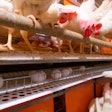Elizabeth Doughman, editor, WATT PoultryUSA and Poultry Future: Hello and welcome to WATT Poultry Chat. I'm Elizabeth Doughman, the editor of WATT PoultryUSA and Poultry Future.
This Watt Poultry Chat is brought to you by Arm & Hammer Animal Nutrition. Arm & Hammer uses cutting-edge research and innovation to deliver performance- and profitability-enhancing animal nutrition and health solutions. Learn more at www.ahfoodchain.com.
Joining us today is Dr. Mueez Ahmad, DVM, poultry technical services manager at Arm & Hammer Animal Nutrition.
Thanks for joining us, Mueez.
Can you briefly explain what Enterococcus is?
Dr. Mueez Ahmad, DVM, poultry technical services manager, Arm & Hammer Animal Nutrition: Enterococcus is a part of the normal intestinal microbiota. It belongs to the Lactobacillus family. It's a huge family.
Some members of Enterococcus have acquired some level of pathogenicity and can cause a vertical and horizontally transmitted disease into the broiler. This bacterium is present in other species, but the broiler is showing a lot more disease symptoms right now. The bacteria acquire various level of pathogenicity and can cause severe embryonic mortality, young chick mortality and older bird infections such as polyserositis, polyarthritis and kinky back disease.
Examples of those pathogenic bacterial species are Enterococcus and Enterococcus faecalis.
Doughman: What is the impact of Enterococcus on the poultry industry?
Ahmad: This disease just really gradually creeped up on the industry there. The Enterococcus-associated diseases have several economic impacts on the broiler industry. It increases two-to-three-fold first week chick mortality. Also, it causes chronic daily mortality resulting from 3 to 5% total mortality in the age of the broiler.
To give you an example of economic impact, if there is a one percent mortality in a given complex that produces one million birds per week, this will end up costing them half a million dollar annually just because of the mortality. We are not counting loss of sale and anything in this thing.
If we look the National Chicken Council data, we see that over the whole United States industry, we produce about 280 to 290 million birds per week. We are producing 5% less birds because part of that is this disease at this point. Indirectly, there is a protein shortage in the United States. Five percent fewer birds end up being close to more than a billion birds at the end of the year. That is a serious economic impact and very soon this could become a billion-dollar disease.
Doughman: What is the solution for Enterococcus-associated diseases?
Ahmad: That's a loaded question, we're still trying to understand this disease at this point, and there is not one good solution out there in the industry now.
Pathogenic Enterococcus is vertically transmitted, so it's coming from the parent flock to the progeny. Obviously, we have to go back to the root cause, get this thing under control from the parent flock.
I think that when it come to the solution of the disease, we can say that antibiotics is not right on the table at this point. Number one, this bacterium is resistant to almost every antibiotic available to the poultry industry. The number two is that when we use the antibiotic, it will also wipe out rest of the good microbiome in the bird. That will end up causing more dysbiosis and cause more performance problem there. There was a knee jerk reaction. Industry has tried the antibiotic, and they really have not been able to come up with some logical treatment plan with that.
The other possibility is that we could develop an autogenous vaccine which can target these organisms and doesn't target the good microbiome and good anthropic there. In this case, yes, there is a whole bunch of research going on.
We collaborated in some of this research to provide them the pathogenic organism so they can develop the vaccine. It's being tried in the industry and it's autogenous. We are not there yet, you know. But I think that I have a great hope that one day the vaccine will work.
However, our Science-Hearted team and myself, we work very heavily on the research. I've been watching this bacterium for last five years, and it’s a growing concern. Every year, we have a higher level of mortality.
We have the technology to develop a targeted bacillus at this point, so we can actually develop a bacillus strain which can target just for the Enterococcus faecalis or secorum or any other Enterococcus. As a matter of fact, we want to target that so we end up having a two bacillus in our library where we can actually use them to target these bacteria and without disturbing the rest of the enterococci family there. So that would be the possible resolution for this disease.
Doughman: What’s needed for the poultry industry to overcome this challenge?
Ahmad: First of all, understanding this disease, because this is still a new disease.
There are not many diagnostic laboratories available in United States. I think the part of the reason it went five years under the radar is because every time we send the sample to a diagnostic lab, they end up diagnosing the secondary bacteria associated with the disease. So, I think that industry really needs a very higher level of laboratory and field diagnostic expertise.
We are working hard to educate the industry. We have several seminars and trainings, and shadow working with industry veterinarian.
But the number one thing is identifying and recognizing that they have a problem there. As I mentioned earlier, this is a vertically transmitted disease in the hatchery. The bacteria can horizontally cross, contaminate the progeny and then cause further acceleration of the disease. The current hatchery sanitation and biosecurity practices are really not equipped to control this disease, so we are moving towards a higher level of sanitation training and biosecurity training in the hatchery to prevent the further transmission of this disease.
We did develop a three-prong approach to control this disease. That's what I would suggest and recommend to the industry to develop a multi-hurdle approach because one approach may not work. It has not worked in the past. What we are recommending is to go back to the root cause. Go back to the breeder and treat those breeders to reduce the Enterococcus faecalis and secorum in their intestinal microbiome there. At the same time, when we reduce the shedding of the pathogenic microbiome, we will also reduce the transmission to the embryo and to the progeny. The next step is going back to the hatchery and develop the robust hatchery sanitation program using existing technology available there in the industry.
There are many companies who have the best hatching sanitation program. We pick the best and we kind of titrate it against the Enterococcus bacteria and see how we can reduce the number and the level of bacteria in the hatching environment there and then. The other thing is controlling the Enterococcus faecalis and secorum in the gastrointestinal tract by two approaches: by reducing the pathogen level but also preventing the leakage of pathogen from the gut to the systemic. This bacteria does not cause any disease in the gut, but if it goes to the systemic, then it will cause and that goes through the leaky gut syndrome. Part of our treatment regime is to control the leaky gut syndrome and enhance the tight junction function in the intestinal tract.
Doughman: Thank you so much for sharing these insights. For more information on the solutions discussed here today, visit Arm & Hammer Animal Nutrition at www.ahfoodchain.com.
Thanks again, Mueez, and thanks to you for tuning in.


















